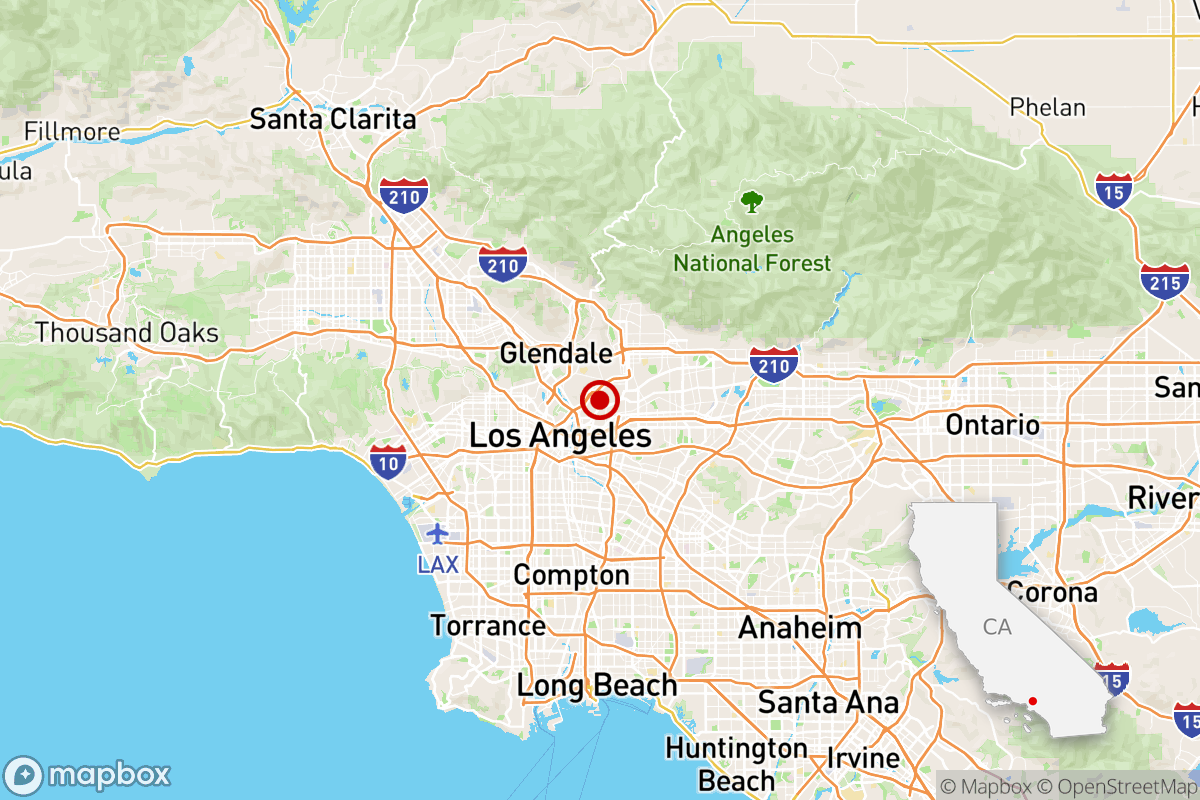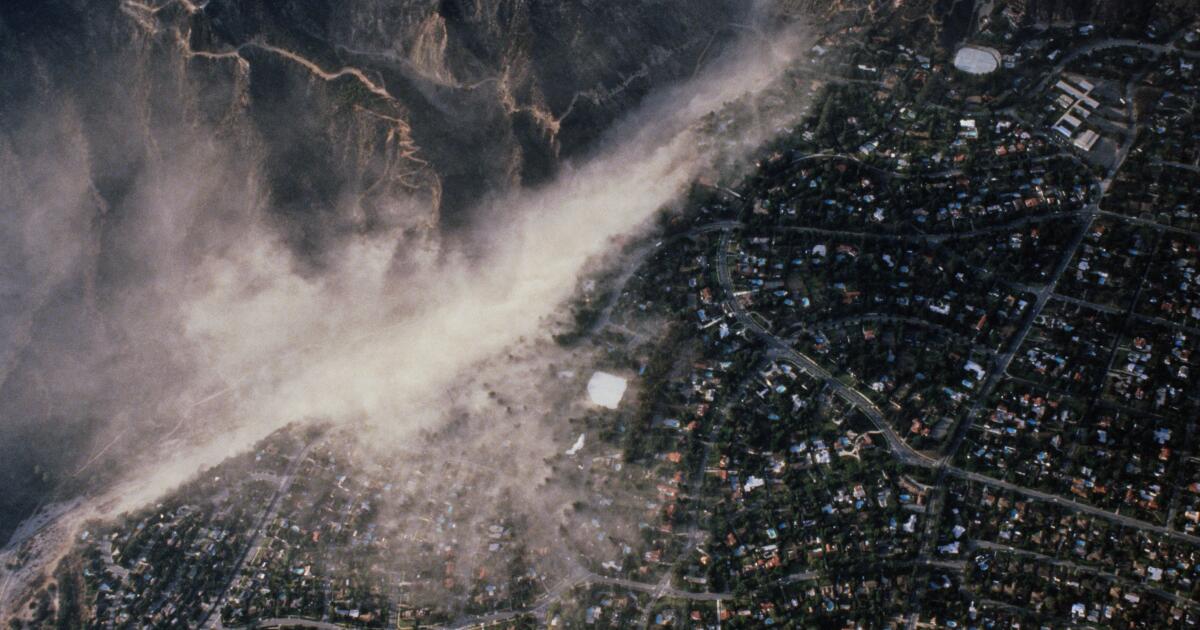Monday’s magnitude 4.4 earthquake centered four miles northeast of downtown Los Angeles was modest but packed quite a jolt.
Although no major damage was reported, experts say the temblor was in the general area of a dangerous fault system — one they have long feared is capable of producing a catastrophic earthquake in the heart of the city.
The quake ruptured on a small section of a fault associated with the Puente Hills thrust fault system, which has long been cited as a major seismic hazard for Southern California because it runs through heavily populated areas and is capable of a huge quake.
“It’s a reminder that this is actually our most dangerous fault,” earthquake expert Lucy Jones said, surpassing the San Andreas.
The length of the fault strand that ruptured and caused Monday’s quake was relatively tiny, perhaps only a few hundred feet across. Small earthquakes happen all the time on relatively tiny fault strands and most of the time are not followed by anything larger.
Still, Angelenos have been feeling rumbling since June from earthquakes centered in the Eastside neighborhood of El Sereno. And it’s a reminder of the seismic threats that are too often ignored in Southern California.
Monday’s earthquake, centered about 1,100 feet southwest of Huntington Drive and Eastern Avenue, occurred in the same general area as a pair of quakes in early June — a magnitude 3.4 on June 2 and a magnitude 2.8 on June 4 — also associated with the Puente Hills thrust fault system. There also was a magnitude 2.9 quake in the area June 24.
“All of these earthquakes are closely spaced in three dimensions, just beneath the main Puente Hills thrust [fault] plane,” USC earth sciences professor James Dolan said. “They’re all associated with the same cluster of small events.
“But the key thing is, they are very small events. These are very small earthquakes that don’t necessarily mean anything in terms of potentially being the harbinger of a future large magnitude earthquake on the Puente Hills thrust,” Dolan said.
Still, people should be aware of the dangerous faults that lie under the metropolitan Los Angeles area.
Californians probably know the most famous of faults, the San Andreas, which in Southern California runs mostly beneath remote deserts and mountains. That fault plays a starring role in the 1978 movie “Superman,” with an aerial image of it in a sparsely populated area.
Despite its rural location, the southern San Andreas fault is considered quite dangerous, mostly because of its massive size and capability to bring strong, destructive shaking to a huge swath of Southern California in an immensely powerful magnitude 8 earthquake — something not seen in modern California history.
A simulation of a plausible major southern San Andreas fault earthquake — a magnitude 7.8 that begins near the Mexican border along the fault plane and unzips all the way to L.A. County’s mountains — could result in a death toll of 1,800 people.
By contrast, an earthquake on the Puente Hills thrust fault system probably would max out at a magnitude 7.5 — still powerful, but less so than the southern San Andreas. The effects, however, would be catastrophic: It could kill far more people — 3,000 to 18,000 people, according to the U.S. Geological Survey and the Southern California Earthquake Center. And the economic loss could be up to $252 billion, which would be the costliest disaster in U.S. history, even exceeding that of Hurricane Katrina in 2005.
A key reason it is so fearsome is its location. The Puente Hills thrust fault system is in a broad zone directly underneath the densest parts of the L.A. area, including downtown Los Angeles, which has many old and unretrofitted buildings, as well as broad swaths of southeast L.A. County, the San Gabriel Valley and northern Orange County.
Among the buildings most at risk are those in with brittle concrete frames,which could crumble in a massive quake.
An interactive Times map illustrates the risk. A hypothetical magnitude 7 earthquake on the Puente Hills thrust fault would cause “violent” shaking, or level 9 on the Modified Mercalli Intensity Scale, over a broad stretch of the region, including Glendale, Koreatown, downtown, South L.A., Pico Rivera, Montebello, East L.A., Monterey Park, Alhambra, San Gabriel and Pasadena. “Violent” shaking is capable of such intensity that it can push buildings off foundations, and cause buildings such as apartments with flimsy first floors propping up carports — so-called “soft story” buildings — to collapse.
This region — from Mid-City to Arcadia and from Burbank to Watts — hasn’t seen that kind of intense shaking in modern times, an indication that surviving a past earthquake is by no means proof that a building will survive the next one. The level of shaking that this region of L.A. County region experienced during the 1994 Northridge earthquake was “strong,” which caused slight damage, if any, while it was the San Fernando Valley that had “severe” or “violent” shaking.
The risk of earthquakes highlights the importance of getting vulnerable buildings retrofitted. But even though some cities have made efforts to require building retrofits, many others have not.
Another problem with a quake along the Puente Hills thrust fault system is that the soft sediment beneath the L.A. Basin amplifies the quake’s energy.

A circle on a map shows the location of Monday’s 4.4. magnitude quake quake in Los Angeles.
(U.S. Geological Survey)
Scientists believe the Puente Hills fault has a major quake roughly every few thousand years — but they don’t know when the last one was. The San Andreas fault has quakes more frequently; it ruptures on average, in a very rough sense, every century or so. In Southern California, the last major earthquake on the San Andreas fault was in 1857, estimated at somewhere around a magnitude 7.8.
But even moderate quakes along the Puente Hills thrust fault system can cause major problems.
In 1987, the magnitude 5.9 Whittier Narrows earthquake left old brick buildings in Whittier’s downtown area battered. The quake also damaged some freeway bridges. More than 100 single-family homes and more than 1,000 apartment units were destroyed. It caused more than $350 million in damage. Eight deaths were reported.
In 2014, a magnitude 5.1 earthquake in La Habra struck under the Puente Hills thrust fault. Residents within 10 miles of the epicenter reported toppled furniture, broken glass and fallen pictures. Several water mains broke, and a rock slide in Carbon Canyon caused a car to overturn, leaving those inside with minor injuries. Officials said more than a dozen homes and apartments were red-tagged because of possible structural damage.
The Puente Hills thrust fault system was previously unknown to scientists when it ruptured in 1987. Scientists discovered the fault in 1999.
Five years earlier, the magnitude 6.7 Northridge earthquake hit on another “invisible” fault — completely underground, without coming to Earth’s surface — that scientists didn’t know about.

Items fell off shelves of a store in Alhambra during Monday’s earthquake.
(Karen Kaplan / Los Angeles Times)
Los Angeles has widely felt two quakes in a week: Monday’s magnitude 4.4 in El Sereno and last week’s magnitude 5.2 about 18 miles southwest of Bakersfield. In both cases, the state’s early warning system sent out alerts.
People should heed the lessons from this modest earthquake, Dolan said, and take action to prepare for future ones, such as buying extra water for their homes and workplaces and securing spaces, such as fastening bookshelves to walls.
“If it inspires even a few people to do that … that’s a good thing for L.A.,” Dolan said.
“People really need to be ready for a very, very large earthquake, or earthquakes, in L.A.’s future,” he said. “It’s going to happen. We don’t know when. We don’t know exactly which fault is going to generate those earthquakes, but they are going to happen.”
